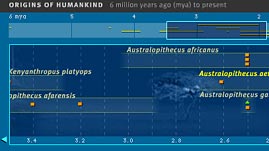Contrary to what many critics have claimed, the theory of evolution does not state that humans evolved from apes or from any other creature that exists today. Rather, what the theory of evolution says is that all organisms are related to all other organisms, that we all share a common ancestor. Humans and chimpanzees share a common ancestor. Zebras and horses share a common ancestor. And if you go back far enough in evolutionary time -- a few billion years -- it is even possible to find an ancestor common to humans and slime mold.
From an evolutionary perspective (and now from a genetic perspective), modern apes -- including gorillas, chimpanzees, and orangutans -- are a human's closest living relatives. Scientists believe that the common ancestor we share with these animals existed 6 to 8 million years ago. Shortly thereafter, this species diverged into two separate ancestral lines, or lineages. One of these lineages ultimately evolved into apes, and the other evolved into early human ancestors called hominids.
In the 6 to 8 million years since the hominid lineage diverged from the ancestral line of the apes, at least a dozen different hominid species have existed. Most of these species were what evolutionary biologists call "dead ends," meaning they became extinct without giving rise to other species. Some of the extinct hominids known today, however, are almost certainly direct ancestors of modern humans. While the total number of species that existed and the relationships among them are still unknown, each fossil that is uncovered by scientists makes our evolutionary history just a little bit clearer.


 Teachers' Domain is proud to be a Pathways portal to the National Science Digital Library.
Teachers' Domain is proud to be a Pathways portal to the National Science Digital Library.